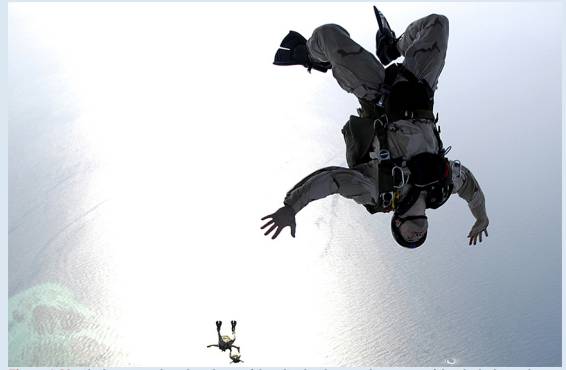
A Parachutist in Free Fall

Figure 1.30 Skydivers can adjust [he velocity of their dive by changing the position of their body during the free fall. (credit: Jeremy T. Lock)
Julie is an avid skydiver. She has more than 30 jumps under her belt and has mastered the art of making adjustments
to her body position in the air to control how fast she falls. If she arches her back and points her belly toward the
ground, she reaches a terminal velocity of approximately 120 mph [176 ft/sec). If, instead, she orients her body with
her head straight down, she falls faster, leaching a terminal velocity of 150 mph (220 ft/sec).
Since Julie will be moving (falling) in a downward direction, we assume the downward direction is positive to simplify
our calculations. Julie executes her jumps from an altitude of 12,500 ft. After she exits the aircraft, she immediately
starts falling at a velocity given by v(t) = 32t. She continues to accelerate according to this velocity function until she
reaches terminal velocity. After she reaches terminal velocity, her speed remains constant until she pulls her ripcord
and slaws down In land.
On her first jump of the day, Julie orients herself in the slower "belly down” position (terminal velocity is 176 ft/sec).
Using this information, answer the following questions.
3. If Julie pulls her ripcord at an altitude of 3000 ft, how long does she spend in a free fall?
Trending nowThis is a popular solution!

Chapter 1 Solutions
Calculus Volume 2
Additional Math Textbook Solutions
Elementary Statistics (13th Edition)
University Calculus: Early Transcendentals (4th Edition)
Elementary Statistics: Picturing the World (7th Edition)
Thinking Mathematically (6th Edition)
Calculus: Early Transcendentals (2nd Edition)
- Chatgpt give wrong answer No chatgpt pls will upvotearrow_forward@when ever one Point sets in x are closed a collection of functions which separates Points from closed set will separates Point. 18 (prod) is product topological space then VaeA (xx, Tx) is homeomorphic to sul space of the Product space (Txa, prod). KeA © The Bin Projection map B: Tx XP is continuous and open but heed hot to be closed. A collection (SEA) of continuos function oha topolgical Space X se partes Points from closed sets inx iff the set (v) for KEA and Vopen set in Xx from a base for top on x.arrow_forwardNo chatgpt pls will upvotearrow_forward
- Make M the subject: P=2R(M/√M-R)arrow_forwardExercice 2: Soit & l'ensemble des nombres réels. Partie A Soit g la fonction définie et dérivable sur R telle que, pour tout réel x. g(x) = - 2x ^ 3 + x ^ 2 - 1 1. a) Étudier les variations de la fonction g b) Déterminer les limites de la fonction gen -oo et en +00. 2. Démontrer que l'équation g(x) = 0 admet une unique solution dans R, notée a, et que a appartient à | - 1 ;0|. 3. En déduire le signe de g sur R. Partie B Soit ƒ la fonction définie et dérivable sur R telle que, pour tout réel s. f(x) = (1 + x + x ^ 2 + x ^ 3) * e ^ (- 2x + 1) On note f la fonction dérivée de la fonction ƒ sur R. 1. Démontrer que lim x -> ∞ f(x) = - ∞ 2. a) Démontrer que, pour tout x > 1 1 < x < x ^ 2 < x ^ 3 b) En déduire que, pour x > 1 0 < f(x) < 4x ^ 3 * e ^ (- 2x + 1) c) On admet que, pour tout entier naturel n. lim x -> ∞ x ^ n * e ^ (- x) = 0 Vérifier que, pour tout réel x, 4x ^ 3 * e ^ (- 2x + 1) = e/2 * (2x) ^ 3 * e ^ (-2x) puis montrer que: lim x -> ∞ 4x ^ 3 * e…arrow_forwardshow me pass-to-passarrow_forward
 Elementary AlgebraAlgebraISBN:9780998625713Author:Lynn Marecek, MaryAnne Anthony-SmithPublisher:OpenStax - Rice University
Elementary AlgebraAlgebraISBN:9780998625713Author:Lynn Marecek, MaryAnne Anthony-SmithPublisher:OpenStax - Rice University Glencoe Algebra 1, Student Edition, 9780079039897...AlgebraISBN:9780079039897Author:CarterPublisher:McGraw Hill
Glencoe Algebra 1, Student Edition, 9780079039897...AlgebraISBN:9780079039897Author:CarterPublisher:McGraw Hill
 Trigonometry (MindTap Course List)TrigonometryISBN:9781337278461Author:Ron LarsonPublisher:Cengage Learning
Trigonometry (MindTap Course List)TrigonometryISBN:9781337278461Author:Ron LarsonPublisher:Cengage Learning Algebra: Structure And Method, Book 1AlgebraISBN:9780395977224Author:Richard G. Brown, Mary P. Dolciani, Robert H. Sorgenfrey, William L. ColePublisher:McDougal LittellAlgebra & Trigonometry with Analytic GeometryAlgebraISBN:9781133382119Author:SwokowskiPublisher:Cengage
Algebra: Structure And Method, Book 1AlgebraISBN:9780395977224Author:Richard G. Brown, Mary P. Dolciani, Robert H. Sorgenfrey, William L. ColePublisher:McDougal LittellAlgebra & Trigonometry with Analytic GeometryAlgebraISBN:9781133382119Author:SwokowskiPublisher:Cengage





